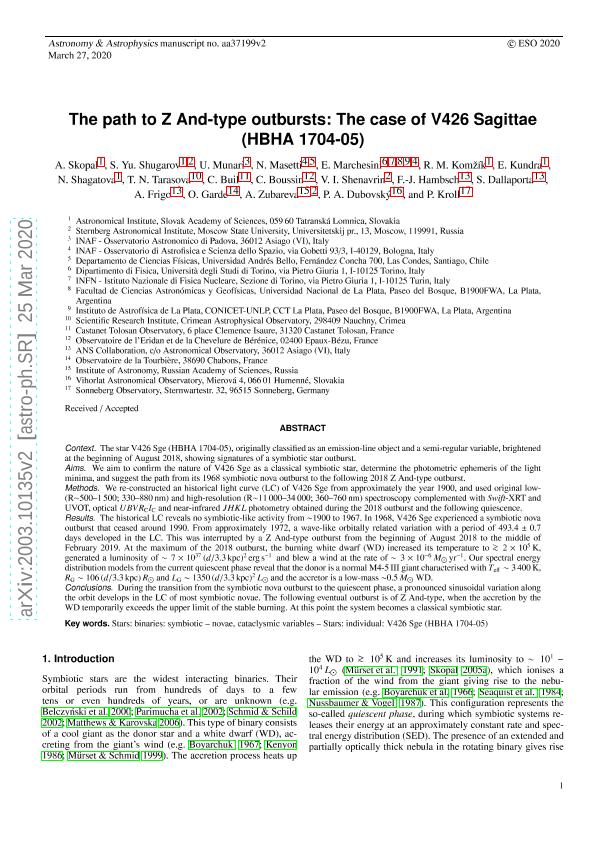Artículo
The path to Z And-type outbursts: The case of V426 Sagittae (HBHA 1704-05)
Skopal, A.; Shugarov, S. Y.; Munari, U.; Masetti, N.; Marchesini, Ezequiel Joaquín ; Komzík, R. M.; Kundra, E.; Shagatova, N.; Tarasova, T. N.; Buil, C.; Boussin, C.; Shenavrin, V. I.; Hambsch, F. J.; Dallaporta, S.; Frigolé, Cecilia Andrea
; Komzík, R. M.; Kundra, E.; Shagatova, N.; Tarasova, T. N.; Buil, C.; Boussin, C.; Shenavrin, V. I.; Hambsch, F. J.; Dallaporta, S.; Frigolé, Cecilia Andrea ; Gardey, Juan Cruz
; Gardey, Juan Cruz ; Zubareva, A.; Dubovský, P. A.; Kroll, P.
; Zubareva, A.; Dubovský, P. A.; Kroll, P.
 ; Komzík, R. M.; Kundra, E.; Shagatova, N.; Tarasova, T. N.; Buil, C.; Boussin, C.; Shenavrin, V. I.; Hambsch, F. J.; Dallaporta, S.; Frigolé, Cecilia Andrea
; Komzík, R. M.; Kundra, E.; Shagatova, N.; Tarasova, T. N.; Buil, C.; Boussin, C.; Shenavrin, V. I.; Hambsch, F. J.; Dallaporta, S.; Frigolé, Cecilia Andrea ; Gardey, Juan Cruz
; Gardey, Juan Cruz ; Zubareva, A.; Dubovský, P. A.; Kroll, P.
; Zubareva, A.; Dubovský, P. A.; Kroll, P.
Fecha de publicación:
04/2020
Editorial:
EDP Sciences
Revista:
Astronomy and Astrophysics
ISSN:
0004-6361
Idioma:
Inglés
Tipo de recurso:
Artículo publicado
Clasificación temática:
Resumen
Context. The star V426 Sge (HBHA 1704-05), originally classified as an emission-line object and a semi-regular variable, brightened at the beginning of August 2018, showing signatures of a symbiotic star outburst. Aims. We aim to confirm the nature of V426 Sge as a classical symbiotic star, determine the photometric ephemeris of the light minima, and suggest the path from its 1968 symbiotic nova outburst to the following 2018 Z And-type outburst. Methods. We re-constructed an historical light curve (LC) of V426 Sge from approximately the year 1900, and used original low- (R ∼ 500-1500; 330-880 nm) and high-resolution (R ∼ 11 000-34 000; 360-760 nm) spectroscopy complemented with Swift-XRT and UVOT, optical UBVRCIC and near-infrared JHKL photometry obtained during the 2018 outburst and the following quiescence. Results. The historical LC reveals no symbiotic-like activity from ∼1900 to 1967. In 1968, V426 Sge experienced a symbiotic nova outburst that ceased around 1990. From approximately 1972, a wave-like orbitally related variation with a period of 493.4 ± 0.7 days developed in the LC. This was interrupted by a Z And-type outburst from the beginning of August 2018 to the middle of February 2019. At the maximum of the 2018 outburst, the burning white dwarf (WD) increased its temperature to ? 2 × 105 K, generated a luminosity of ∼7 × 1037 (d/3.3 kpc)2 erg s-1 and blew a wind at the rate of ∼3 × 10-6 M yr-1. Our spectral energy distribution models from the current quiescent phase reveal that the donor is a normal M4-5 III giant characterised with Teff ∼ 3400 K, RG ∼ 106 (d/3.3 kpc) R and LG ∼ 1350 (d/3.3 kpc)2 L and the accretor is a low-mass ∼0.5 M WD. Conclusions. During the transition from the symbiotic nova outburst to the quiescent phase, a pronounced sinusoidal variation along the orbit develops in the LC of most symbiotic novae. The following eventual outburst is of Z And-type, when the accretion by the WD temporarily exceeds the upper limit of the stable burning. At this point the system becomes a classical symbiotic star.
Archivos asociados
Licencia
Identificadores
Colecciones
Articulos(IALP)
Articulos de INST.DE ASTROFISICA LA PLATA
Articulos de INST.DE ASTROFISICA LA PLATA
Citación
Skopal, A.; Shugarov, S. Y.; Munari, U.; Masetti, N.; Marchesini, Ezequiel Joaquín; et al.; The path to Z And-type outbursts: The case of V426 Sagittae (HBHA 1704-05); EDP Sciences; Astronomy and Astrophysics; 636; A77; 4-2020; 1-18
Compartir
Altmétricas



